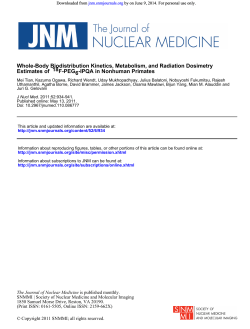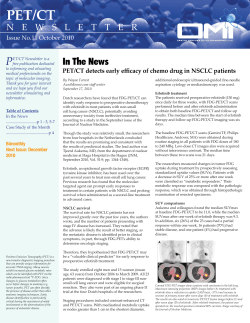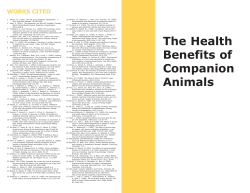
by on June 9, 2014. For personal use only. Downloaded from jnm.snmjournals.org
Downloaded from jnm.snmjournals.org by on June 9, 2014. For personal use only. Incidental Diagnosis of Thrombus Within an Aneurysm on 18F-FDG PET/CT: Frequency in 926 Patients Razi Muzaffar, Ganesh Kudva, Nghi C. Nguyen and Medhat M. Osman J Nucl Med. Published online: August 4, 2011. Doi: 10.2967/jnumed.111.091264 This article and updated information are available at: http://jnm.snmjournals.org/content/early/2011/08/04/jnumed.111.091264 Information about reproducing figures, tables, or other portions of this article can be found online at: http://jnm.snmjournals.org/site/misc/permission.xhtml Information about subscriptions to JNM can be found at: http://jnm.snmjournals.org/site/subscriptions/online.xhtml JNM ahead of print articles have been peer reviewed and accepted for publication in JNM. They have not been copyedited, nor have they appeared in a print or online issue of the journal. Once the accepted manuscripts appear in the JNM ahead of print area, they will be prepared for print and online publication, which includes copyediting, typesetting, proofreading, and author review. This process may lead to differences between the accepted version of the manuscript and the final, published version. The Journal of Nuclear Medicine is published monthly. SNMMI | Society of Nuclear Medicine and Molecular Imaging 1850 Samuel Morse Drive, Reston, VA 20190. (Print ISSN: 0161-5505, Online ISSN: 2159-662X) © Copyright 2011 SNMMI; all rights reserved. Downloaded from jnm.snmjournals.org by on June 9, 2014. For personal use only. Journal of Nuclear Medicine, published on August 4, 2011 as doi:10.2967/jnumed.111.091264 Incidental Diagnosis of Thrombus Within an Aneurysm on 18F-FDG PET/CT: Frequency in 926 Patients Razi Muzaffar1, Ganesh Kudva2, Nghi C. Nguyen1, and Medhat M. Osman1,3 1Division of Nuclear Medicine, Department of Radiology, Saint Louis University, Saint Louis, Missouri; 2Division of Hematology/ Oncology, Department of Internal Medicine, Saint Louis University, Saint Louis, Missouri; and 3Saint Louis VA Medical Center, Saint Louis, Missouri Our objective was to evaluate the incidence of aneurysm and the frequency of thrombus within an aneurysm on unenhanced 18F-FDG PET/CT studies. Methods: We reviewed 1,540 PET/ CT scans from 926 patients. A log recorded whether each case of aneurysm had a suspected thrombus. The maximal standardized uptake value of the patent vessel was compared with the thrombus. Findings were confirmed using all available follow-up data. Results: Aneurysm was found incidentally in 16 (1.7%) of the 926 patients, with 15 occurring in the abdominal aorta and 1 in the internal jugular vein. Seven of these 16 patients had shown suggestions of thrombus on unenhanced PET/CT, and in all 7, thrombi were confirmed on contrastenhanced CT. Conclusion: In 1.7% of patients, aneurysm was found incidentally on PET/CT, and thrombus was present in 44% of these cases. Key Words: cardiology (clinical); PET/CT; vascular; aneurysm; thrombus J Nucl Med 2011; 52:1–4 DOI: 10.2967/jnumed.111.091264 A ccording to the American Heart Association, the overall leading cause of death in North America continues to be atherosclerotic cardiovascular disease (1). The patient populations that typically undergo PET/CT—the elderly and patients receiving chemotherapy or radiation therapy—are at a greater risk of developing atherosclerotic cardiovascular disease. Atherosclerosis is a progressive disease characterized by thickening of the artery walls. The thickening is composed of a fibrin layer incorporated with blood cells, platelets, blood proteins, and cellular debris, and the most susceptible vessels are the coronary arteries, popliteal arteries, descending thoracic aorta, carotid arteries, and vessels of the circle of Willis. The main complications of plaque formation include myocardial infarcts, thromboembolic cerebral infarcts, and aortic aneurysms and dissection (2). The most Received Apr. 4, 2011; revision accepted May 24, 2011. For correspondence or reprints contact: Medhat M. Osman, Saint Louis University, Department of Radiology/Division of Nuclear Medicine, Saint Louis VA Medical Center, 3635 Vista Ave., 2-DT, St. Louis, MO 63110. E-mail: mosman@slu.edu COPYRIGHT ª 2011 by the Society of Nuclear Medicine, Inc. common type of aneurysm seen on PET/CT studies, the abdominal aortic aneurysm (AAA), is one that reaches an anteroposterior diameter of 3.0 cm. In men, the incidence of a 3.0- to 4.9-cm AAA ranges from 1.3% (at age 45–54 y) to 12.5% (at age 75–84 y), and in women, the incidence ranges from 0% to 5.2%, respectively. However, the incidence of AAA in the cancer population is not well known. The risk of rupture is greater in larger AAAs because they expand more rapidly than smaller AAAs, and a thrombus that is growing also has a greater risk of rupture. Intraluminal thrombus is present to variable degrees in approximately 75% of AAAs (3). Rupture of an AAA has been reported to be the tenth leading cause of death in the United States, and the mortality rate is as high as 90% (4,5). An AAA is usually diagnosed by physical examination, ultrasound, or CT. Since the introduction of PET/CT, numerous studies have shown that whole-body dual-modality imaging is better than PET or CT alone for staging and restaging most cancers (6). The National Oncologic PET Registry was developed in 2006 to collect data on the clinical utility of PET. By the end of November 2010, this registry had evaluated more than 170,000 PET studies performed at 2,146 centers (7). A study using data from the registry concluded that 18F-FDG PET brought about a change in management for 38% of cases (95% confidence interval, 37.6%–38.5%) across cancer types, proving that the use of PET should not be restricted to particular cancer types or testing indications (8). With 18F-FDG, PET can be used to diagnose, stage, and restage many types of cancer with an accuracy ranging from 80% to 90% and is often better than anatomic imaging (9). However, as more studies are performed, many incidental PET/CT findings have proven to be clinically significant. Identifying asymptomatic patients and intervening before a major event continues to be a major concern. On intravenous administration, 18F-FDG is cleared rapidly from circulation, providing a high target-to-background ratio to detect hypermetabolic lesions such as malignant tumors, infection, or inflammation. A minimal amount of physiologic activity remains in circulation, as reflected by a uniform 18F-FDG distribution within a vessel. However, when THROMBUS IN ANEURYSM jnm091264-sn n 7/29/11 ON PET/CT • Muzaffar et al. Copyright 2011 by Society of Nuclear Medicine. 1 Downloaded from jnm.snmjournals.org by on June 9, 2014. For personal use only. the normal blood flow is interrupted by the chronic presence of a nonmetabolically active material such as a thrombus within the lumen, a region of tracer void is seen on PET. Increased 18F-FDG uptake in a vessel wall in early lesions is due to the accelerated localization of inflammatory and immune cells in the vessel wall, in contrast to a thrombus within the lumen (devoid of inflammatory cells). A finding of increased uptake is suggestive of plaque destabilization and creates concern about adverse events (10). The objective of our study was to determine the incidence of aneurysm in the cancer population and to evaluate the frequency with which thrombus is incidentally detected within an aneurysm on 18FFDG PET/CT studies, using data from PET and unenhanced CT components. performed before the emission acquisition. CT data were used for image fusion and for generation of the CT transmission map. The arms were placed above the patient’s head for CT acquisitions, except for patients with head and neck cancer, who placed their arms at their sides. Per our protocol, the CT images were obtained without oral or intravenous contrast material. MATERIALS AND METHODS Image Analysis The PET/CT images were retrospectively evaluated on a Gemini TF Extended Brilliance Workspace (Philips) by 2 boardcertified nuclear medicine physicians. A log recorded whether each case of aneurysm had a thrombus suspected on the basis of PET and unenhanced CT. When a thrombus was suspected, the maximal standardized uptake value of the patent vessel at the site of the aneurysm was compared with that at the site of the suspected thrombus. Findings were subsequently confirmed after a thorough review of the medical records, including all clinical notes and radiology reports. Patient Selection We reviewed 1,540 consecutive 18F-FDG PET/CT studies of 926 patients who were scanned because of known or suspected cancer. PET/CT An intravenous 5.18 MBq (0.14 mCi)/kg injection of 18F-FDG was administered after the patient had fasted for at least 4 h. The patient sat in a quiet injection room without talking during the subsequent 60-min 18F-FDG uptake phase and was allowed to breathe normally during image acquisition. All scans were acquired using a Gemini PET/CT scanner (Philips). CT The CT component of the Gemini consisted of a 16-slice helical scanner with a gantry port of 70 cm. Images were acquired at 12– 13 bed positions, using the following parameters: 120–140 kV and 33–100 mAs (based on body mass index), 0.5 s per CT rotation, a pitch of 0.9, and a 512 · 512 matrix. The CT acquisition was PET Scanning and Image Processing The PET component of the Gemini is composed of gadolinium oxyorthosilicate–based crystals. Emission data were acquired for 12–13 bed positions, at 3 min per bed position. The field of view was from the top of the head to the bottom of the feet. The 3dimensional acquisition parameters consisted of a 128 · 128 matrix and an 18-cm field of view with a 50% overlap. The images were processed using a 3-dimensional row-action maximum-likelihood algorithm. Total scanning time per patient was 36–39 min. RESULTS An aneurysm was found incidentally on 18F-FDG PET/ CT scans in 16 (1.7%) of the 926 patients (12 men and 4 women; mean age, 72.6 y; 95% confidence interval, 1.7 6 0.8). The aneurysm was in the internal jugular vein in 1 patient and in the abdominal aorta in the remaining 15. Table 1 summarizes the characteristics of these patients. ½Table 1 TABLE 1 Characteristics of Patients with Thrombus Patient no Age (y) Sex 1 2 3 4 5 6 7 8 9 10 11 12 13 14 15 16 76 73 63 79 58 88 66 73 82 74 71 74 72 66 66 85 F M M M F M M M M M M M M M M F Type of cancer Site of aneurysm Size of aneurysm (cm) SUVmax of vessel SUVmax of thrombus Lymphoma Lung cancer Head/neck cancer Lung cancer Melanoma Rectal cancer Lung cancer Head/neck cancer Lung cancer Lung cancer Lung cancer Lung cancer Lung cancer Lung cancer No malignancy Lung cancer Abdominal aortic Abdominal aortic Abdominal aortic Abdominal aortic Internal jugular Abdominal aortic Abdominal aortic Abdominal aortic Abdominal aortic Abdominal aortic Abdominal aortic Abdominal aortic Abdominal aortic Abdominal aortic Abdominal aortic Abdominal aortic 6.7 3.7 4.4 7.6 1.4 3.9 4.0 5.5 5.3 3.2 5.4 6.7 5.6 4.0 4.0 4.3 1.8 1.9 2.2 1.5 Occluded* 2.1 1.6 2.5 2.0 1.7 1.7 1.9 1.8 1.7 1.8 4.9 0.3 0.8 0.5 0.5 1.6 1.2 0.8 *Previously unknown finding requiring emergent treatment. SUVmax 5 maximal standardized uptake value. 2 THE JOURNAL OF NUCLEAR MEDICINE • Vol. 52 • No. 9 • September 2011 jnm091264-sn n 7/29/11 Downloaded from jnm.snmjournals.org by on June 9, 2014. For personal use only. trast-enhanced CT confirmed these findings, and the patient received an intravascular stent graft the following week. Figure 3 shows a previously unknown complete thrombosis ½Fig: 3 of the left internal jugular vein in a 57-y-old woman with a history of melanoma. Contrast-enhanced CT confirmed the findings, and the patient was emergently admitted and treated with anticoagulation therapy. However, the presentation of this patient was different from the others. The occluded vessel showed reduced uptake in the lumen but increased uptake in the walls. Of the remaining 5 patients with findings suggestive of thrombus formation, 2 died shortly after PET/CT was performed, 1 received a stent. and 2 began anticoagulation therapy. RGB DISCUSSION FIGURE 1. Large ascending AAA in 82-y-old woman with history of lung cancer. Unenhanced CT shows uniformly dense aortic aneurysm. Uniform physiologic 18F-FDG uptake is seen within lumen of aortic aneurysm on PET. Seven (44%) of the 16 patients had 18F-FDG PET/CT findings suggestive of thrombus, and the presence of a thrombus was subsequently confirmed on contrast-enhanced CT (95% confidence interval, 44 6 24). The mean diameter of aneurysms was 4.85 cm (range, 1.7–7.6 cm), the mean maximal standardized uptake value of patent vessels with thrombi was 1.9 (range, 1.5–2.2), and the mean maximal standardized uptake value of thrombi was 0.8 (range, 0.3– 1.6) (P , 0.01). ½Fig: 1 Figure 1 shows a 5.5-cm ascending AAA in an 82-y-old woman with a history of lung cancer. PET/CT shows uniform vascular uptake without evidence of thrombus. Con½Fig: 2 trast-enhanced CT confirmed these findings. Figure 2 shows a 7.2-cm AAA in a 78-y-old man with a history of lung cancer. PET/CT shows a tracer void in the lateral and posterior aspects of the vessel, suggestive of thrombus. Con- RGB FIGURE 2. Large AAA in 78-y-old man with history of lung cancer. Unenhanced CT shows uniformly dense aortic aneurysm. PET shows region of tracer void in lateral aspect of aneurysm, suggestive of thrombus, and physiologic blood-pool activity medially giving ying-yang pattern. Suspected thrombus was confirmed with contrast-enhanced CT. The use of 18F-FDG PET has been gaining momentum in the diagnosis, staging, and restaging of many cancers and is often better than anatomic imaging alone (6). According to the Academy of Molecular Imaging, there are more than 5,000 PET/CT systems installed worldwide, making PET/ CT one of the fastest-growing imaging modalities (11). The fusion of functional and anatomic imaging continues to evolve and provide valuable clinical information. PET/CT provides information additional to that of either modality alone and has become the first-line modality for staging and restaging tumors and for evaluating the response of various types of cancer to therapy (12). Currently, the CT component of PET/CT in many centers continues to be a low-dose, unenhanced study used mainly for image fusion and attenuation correction. A recent study demonstrated that 73% of sites worldwide use a dedicated low-dose CT acquisition for PET/CT images (13). However, even in the absence of contrast enhancement, useful information can be gained by a skilled reader for 18F-FDG-avid or non–18F-FDG-avid abnormalities. A study assessed the incidental non–18F-FDG-avid findings in 250 PET/CT scans of various types of cancers. It revealed clinically significant incidental findings in 3% of patients (14). In our study, 16 (1.7%) of 1,540 PET/CT scans (926 patients) revealed an incidental finding of aneurysm. Of these 16 scans, 7 (44%) had an incidental finding of thrombus, each of which was confirmed on contrastenhanced CT. Treatment of thrombus is usually altered after the detection of venous thrombosis. However, treatment of an arterial thrombus is based on the presence or absence of embolism while taking into account the risk of bleeding from aneurysmal rupture. In the rare occurrence of patients with cancer and acute arterial thrombus, anticoagulation has been successfully used. Overall, the prognosis for any cancer may be worsened by concurrent thrombosis (15,16). To the best of our knowledge, this study is the first to determine the incidence of aneurysm in a population of cancer patients who underwent PET/CT. Also, despite a handful of case reports, this could be the first study associating an intravessel region of PET tracer void with THROMBUS IN ANEURYSM jnm091264-sn n 7/29/11 ON PET/CT • Muzaffar et al. 3 Downloaded from jnm.snmjournals.org by on June 9, 2014. For personal use only. FIGURE 3. Fully occluded left internal jugular vein in 57-y-old woman with history of melanoma. Unenhanced CT shows subtly hypodense left internal jugular vein. PET shows increased 18F-FDG uptake along course of vessel walls, with relative photopenia throughout lumen. Findings suggest acute process with accumulation of inflammatory and immune cells in vessel wall, with fully occluded lumen. Contrast-enhanced CT confirmed findings, showing no enhancement of left internal jugular vein, as compared with right. RGB a suggestion of thrombus formation. Thinner thrombi can be difficult to detect because of the limited spatial resolution of PET and artifacts associated with aortic pulsation and patient motion. Our study is not without limitations. The CT component of the PET/CT study was done without contrast enhancement and using a lower-dose technique. Given that thrombus formation is best visualized with contrast material, it is likely that the current study may have underestimated the frequency of thrombus formation within an aneurysm. Nevertheless, unenhanced CT, when combined with PET, has been proven to show some findings that are infrequent but significant. CONCLUSION Our data suggest that 1 of every 50 oncologic PET/CT studies will show an aneurysm, and about half of these will contain a thrombus. We believe an incidental finding of 18FFDG uptake within an aneurysm with a relatively cold area within the vessel is highly suggestive of a thrombus and requires further evaluation. These findings usually alter the prognosis and treatment of venous thrombosis and may do so for arterial aneurysmal thrombosis as well. DISCLOSURE STATEMENT The costs of publication of this article were defrayed in part by the payment of page charges. Therefore, and solely to indicate this fact, this article is hereby marked “advertisement” in accordance with 18 USC section 1734. ACKNOWLEDGMENT No potential conflict of interest relevant to this article was reported. 4 THE JOURNAL OF REFERENCES 1. Kavey RE, Daniels SR, Lauer RM, et al. American Heart Association guidelines for primary prevention of atherosclerotic cardiovascular disease beginning in childhood. Circulation. 2003;107:1562–1566. 2. Vallabhajosula S, Fuster V. Atherosclerosis: imaging techniques and the evolving role of nuclear medicine. J Nucl Med. 1997;38:1788–1796. 3. Harter LP, Gross BH, Callen PW, Barth RA. Ultrasonic evaluation of abdominal aortic thrombus. J Ultrasound Med. 1982;1:315–318. 4. Lloyd-Jones D, Adams R, Carnethon M, et al. Heart disease and stroke statistics 2009 update: a report from the American Heart Association Statistics Committee and Stroke Statistics Subcommittee. Circulation. 2009;119:e21–e181. 5. Kazi M, Thyberg J, Religa P. Influence of intramural thrombus on structural and cellular composition of abdominal aortic aneurysm wall. J Vasc Surg. 2003;38:1283–1292. 6. Czernin J, Allen-Auerback M, Schelbert HR. Improvements in cancer staging with PET/CT: literature based evidence as of September 2006. J Nucl Med. 2007;48(suppl 1):78S–88S. 7. NOPR update: monthly status report. National Oncologic PET Registry Web site. Available at: http://www.cancerpetregistry.org/status.htm. Updated February 7, 2011. Accessed July 13, 2011. 8. Hillner BE, Siegel BA, Shields AF, et al. Relationship between cancer type and impact of PET and PET/CT on intended management: findings of the National Oncologic PET Registry. J Nucl Med. 2008;49:1928–1935. 9. Czernin J, Phelps ME. Positron emission tomography scanning: current and future applications. Annu Rev Med. 2002;53:89–112. 10. Rominger A, Saam T, Wolpers S, et al. PET/CT identifies patients at risk for future vascular events in an otherwise asymptomatic cohort with neoplastic disease. J Nucl Med. 2009;50:1611–1620. 11. International Survey of PET/CT Operations and Oncology Imaging 2010. Academy of Molecular Imaging Web site. Available at: http://www.ami-imaging.org/ index.php?option5com_content&task5view&id5181. Accessed July 13, 2011. 12. Antoch G, Vogt FM, Freudenberg LS, et al. Whole-body dual modality PET/CT and whole-body MRI for tumor staging in oncology. JAMA. 2003;290:3199– 3206. 13. Beyer T, Czernin J, Freudenberg LS. Variations in clinical PET/CT operations: results of an international survey of active PET/CT users. J Nucl Med. 2011;52:303–310. 14. Osman MM, Cohade C, Fishman EK, et al. Clinically significant incidental findings on the unenhanced CT portion of PET/CT studies: frequency in 250 patients. J Nucl Med. 2005;46:1352–1355. 15. Poirée S, Monnier-Cholley L, Tubiana JM, Arrivé L. Acute abdominal aortic thrombosis in cancer patients. Abdom Imaging. 2004;29:511–513. 16. Dieckmann KP, Gehrckens R. Thrombosis of abdominal aorta during cisplatinbased chemotherapy of testicular seminoma: a case report. BMC Cancer. 2009;9:459. NUCLEAR MEDICINE • Vol. 52 • No. 9 • September 2011 jnm091264-sn n 7/29/11
© Copyright 2025





















